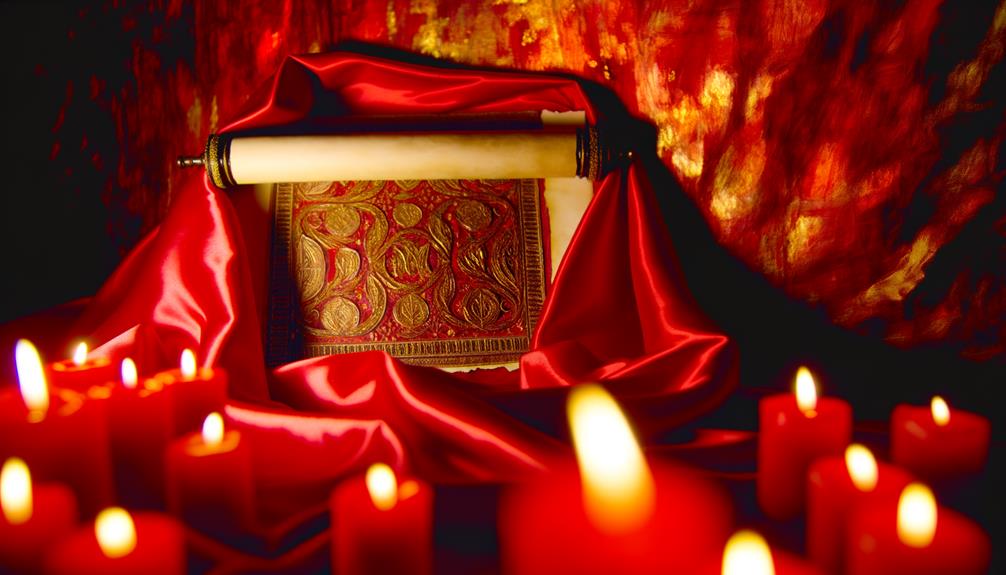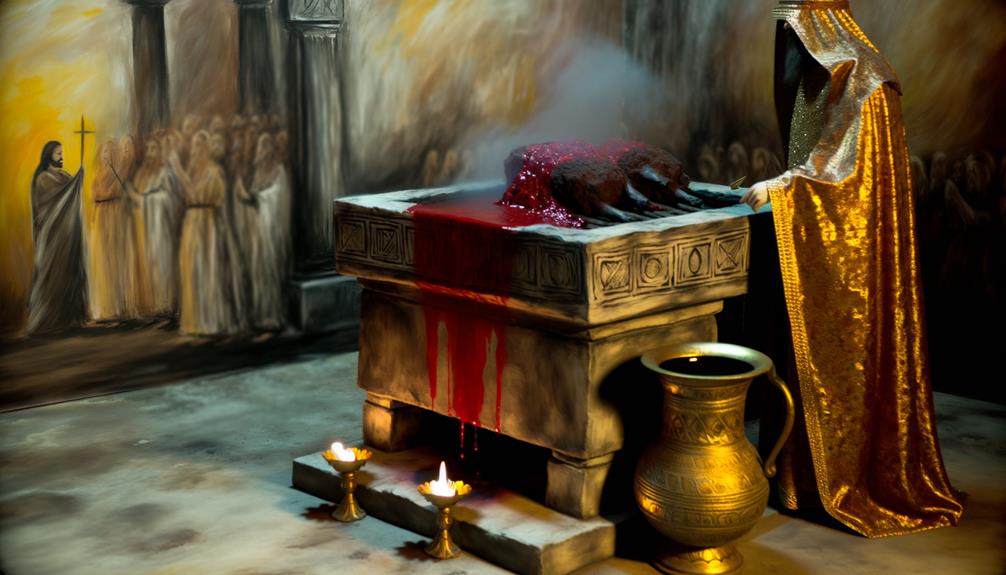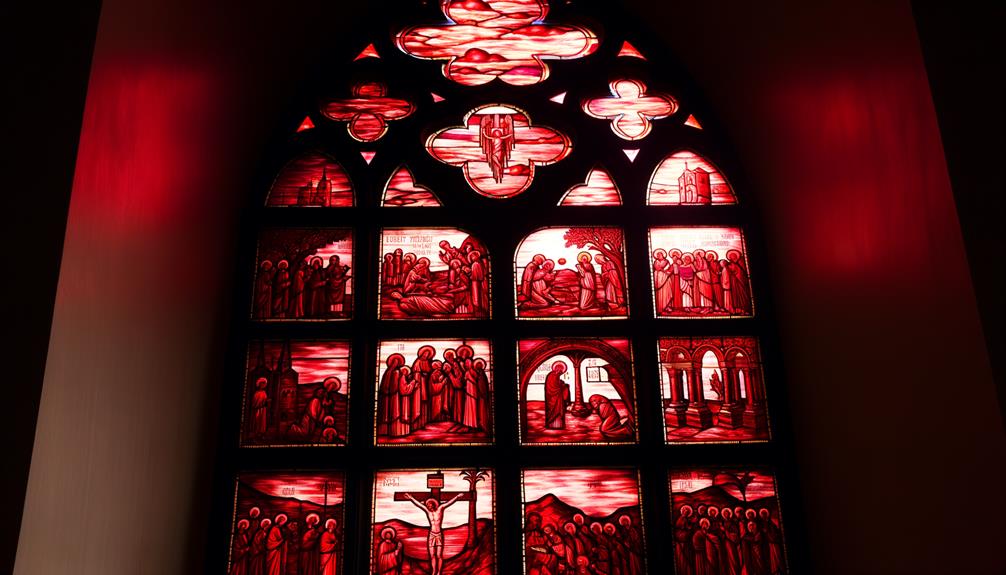Crimson Meaning In The Bible: Sin and Redemption
In the Bible, crimson is imbued with profound symbolism, representing the gravity of sin, the necessity of sacrifice, and the hope of redemption. Scripture such as Isaiah 1:18 uses crimson to depict the severity of sin, contrasting it with the potential for divine forgiveness.
Old Covenant rituals involving crimson blood highlight the sacrificial atonement essential for reconciliation with God. Additionally, the scarlet thread in Joshua 2:18 conveys themes of protection and divine mercy.
These multifaceted representations of crimson underpin the narrative of redemption and hint at the profound theological insights that arise from examining these symbols in biblical context.

Crimson Meaning in the Bible: Symbolism of Sin and Redemption
| Aspect | Description |
|---|---|
| Color Description | Deep red or scarlet |
| Biblical References | Isaiah 1:18, Exodus 26:1, Jeremiah 4:30 |
| Symbolism | Sin, guilt, sacrifice, and atonement |
| In Isaiah 1:18 | “Though your sins be as scarlet, they shall be white as snow” |
| Use in Tabernacle | Crimson threads used in holy garments and the tabernacle |
| Cultural Context | Associated with wealth, royalty, and ritual purity |
| Spiritual Implication | Represents the depth of sin and the grace of divine forgiveness |
| Relevance Today | Encourages reflection on redemption and the power of spiritual cleansing |
Crimson in Biblical Symbolism

Crimson, a vivid red hue, frequently appears in the Bible, symbolizing themes of sin, sacrifice, and redemption. The color crimson often represents the dire nature of sin, as seen in Isaiah 1:18, where sins are described as ‘scarlet’ and ‘crimson,’ signifying their grievousness and depth.
Additionally, crimson denotes the concept of atonement and purification. This transformative symbolism underscores God’s mercy, offering redemption despite humanity’s inherent sinfulness.
Importantly, crimson’s association with sacrifice is evident in its parallel to blood, a recurring element in biblical rites that prefigure ultimate atonement through Christ.
Consequently, crimson serves as a multifaceted symbol, intertwining human fallibility with divine grace, emphasizing the profound narrative of redemption woven throughout the biblical text.
Old Testament Blood Sacrifices

In the Old Scripture, blood sacrifices were central to religious practice, symbolizing both the gravity of sin and the necessity of atonement.
These rituals, often involving the shedding of crimson blood, underscored the covenantal relationship between God and His people.
The sacrificial offerings not only facilitated reconciliation but also highlighted the profound significance of obedience and repentance in maintaining divine favor.
Significance of Blood Offerings
The significance of blood offerings in the Old Scriptures is deeply rooted in the covenantal relationship between God and His people, symbolizing atonement, purification, and a profound spiritual connection.
Blood, viewed as the essence of life, was integral to sacrificial rituals, representing the surrendering of life to God. These offerings, detailed in Levitical laws, were seen as necessary for expiation of sins and restoring purity.
The ritual shedding of blood served as a tangible reminder of the gravity of sin and the cost of reconciliation. Through these sacrificial acts, the Israelites were constantly reminded of their dependence on divine mercy and the sanctity of their covenant with God.
Blood offerings consequently encapsulated the profound interplay between divine justice and mercy.
Covenant and Atonement Rituals
Central to the Old Scripture’s religious framework, blood sacrifices underscored the covenantal themes of atonement and divine-human reconciliation.
The ritualistic shedding of blood, particularly evident in Levitical laws, signified purification and the expiation of sin.
This crimson symbol, seen in sacrifices like the Passover lamb or the Yom Kippur offerings, represented the sanctity of life and the gravity of transgression.
Blood, as life’s essence, acted as an intermediary, bridging the gap between a holy deity and a fallible humanity.
These rites reinforced a solemn understanding: atonement necessitated a tangible, sacrificial cost.
Consequently, the act of bloodletting in covenantal contexts served not merely as ritual but as profound theological symbolism, highlighting the relational dynamics between God and His people.
The Significance of Scarlet Thread

The scarlet thread, frequently mentioned in biblical narratives, serves as a potent symbol with multifaceted implications.
Its recurring presence underscores themes of redemption and purification, while its use in various rituals highlights its integral role in ancient religious practices.
Symbolism in Ancient Texts
Scarlet thread, often mentioned in ancient biblical texts, serves as a potent symbol of redemption and covenant. Its recurring presence in scripture underscores its theological significance, particularly in relation to divine promises and human faithfulness. The symbolism of the scarlet thread extends beyond mere color; it encapsulates layers of meaning within the biblical narrative.
| Text Reference | Symbolism | Interpretation |
|---|---|---|
| Joshua 2:18 | Rahab’s scarlet cord | Protection and inclusion |
| Genesis 38:28-30 | Tamar’s twins’ scarlet thread | Lineage and divine intervention |
| Leviticus 14:6 | Cleansing of leprosy | Purification and restoration |
| Numbers 19:6 | Ritual purification | Holiness and consecration |
| Exodus 26:1 | Tabernacle construction | Sacredness and divine presence |
This intricate symbolism elucidates how the scarlet thread weaves through diverse narratives, creating a tapestry of divine interaction and human experience.
Connection to Redemption
Embedded within the biblical narrative, the scarlet thread emerges as a profound symbol of redemption, intricately linked to God’s covenantal promises and the unfolding of salvation history. This motif weaves through various texts, highlighting the transformation from sin to salvation.
Remarkably, the scarlet thread signifies:
- Rahab’s Salvation: In the Book of Joshua, Rahab’s use of a scarlet thread guaranteed her family’s safety, symbolizing divine mercy and protection.
- Covenantal Blood: The crimson hue parallels the blood used in covenant-making rituals, denoting purification and atonement.
- Christ’s Sacrifice: The New Testament draws a direct line to Christ’s redemptive blood, fulfilling the ancient symbol.
- Passover Lamb: The blood marking Israelite doorposts prefigures Christ, establishing a continuum of deliverance.
This thematic thread underscores the continuity and depth of God’s redemptive plan.
Scarlet Thread in Rituals
In the context of biblical rituals, the scarlet thread emerges as a potent emblem of sanctification and divine covenant, reflecting its profound theological significance.
This symbol is prominently featured in the narrative of Rahab, where the scarlet cord in her window signified salvation and divine promise (Joshua 2:18).
Additionally, in the purification rites prescribed in Leviticus, a scarlet thread was used alongside cedarwood and hyssop, underscoring its role in atonement and ritual cleansing (Leviticus 14:4-6).
The scarlet thread’s recurring presence in these sacred contexts emphasizes its association with protection, redemption, and covenantal faithfulness.
Consequently, the scarlet thread operates as a tangible representation of God’s enduring grace and the transformative power of divine intervention in the biblical tradition.
Crimson and Sin

Throughout the Bible, the color crimson is frequently employed as a potent symbol for sin and transgression, reflecting the deep stain that sin leaves on the soul. This symbolic association is underscored by several scriptural instances:
- Isaiah 1:18: ‘Though your sins are like scarlet, they shall be as white as snow; though they are red as crimson, they shall be like wool.’
- Joshua 2:18: The scarlet cord used by Rahab, symbolizing her past life of sin.
- Lamentations 4:5: Describes the fall from grace, akin to a rich crimson turning to ash.
- Revelation 17:3-4: The harlot dressed in scarlet, symbolizing corruption and moral decay.
Such imagery poignantly conveys the pervasive and indelible nature of sin.
Crimson as a Symbol of Redemption

The color crimson, often associated with sin, also profoundly represents redemption in the Bible, illustrating the transformative power of divine forgiveness.
This dual symbolism is evident in passages such as Isaiah 1:18, where the prophet declares, ‘Though your sins are like scarlet, they shall be as white as snow; though they are red like crimson, they shall become like wool.’
Here, crimson signifies the potential for spiritual cleansing and renewal. This metaphor underscores the belief that redemption is attainable through penitence and divine grace.
Jesus’ Atoning Sacrifice

The crimson hue of Jesus’ blood is profoundly symbolic, representing the ultimate atonement for humanity’s sins.
Through His sacrificial death, the concept of redemption is both vividly and intricately illustrated, underscoring the theological significance of His sacrifice.
This act of atonement serves as a cornerstone for understanding the transformative power of Christ’s blood in Christian doctrine.
Symbolism of Jesus’ Blood
Frequently invoked in Christian theology, the symbolism of Jesus’ blood serves as a profound representation of his atoning sacrifice for humanity’s sins. This potent imagery underpins several theological constructs:
- Purification: Symbolizing the cleansing of sin, Jesus’ blood is seen as washing away impurities (1 John 1:7).
- Covenant: Representing the new covenant between God and humanity, it signifies a divine promise (Luke 22:20).
- Redemption: Highlighting the ransom paid for the liberation from sin’s bondage (Ephesians 1:7).
- Life-giving: Emphasizing spiritual renewal and eternal life, Jesus’ blood is considered life-giving (John 6:53-56).
These elements collectively underscore the transformative essence of Jesus’ sacrificial act, imbuing it with profound theological significance.
Redemption Through His Sacrifice
Central to Christian soteriology, Jesus’ atoning sacrifice is regarded as the ultimate act of redemption, liberating humanity from the bondage of sin and reconciling them with God. The crimson hue of Jesus’ blood symbolizes the profound cost of this divine act.
Through His crucifixion, the penalty of sin was paid, fulfilling Old scriptures and establishing a new covenant. The following table elucidates key theological aspects of redemption through His sacrifice:
| Aspect | Explanation |
|---|---|
| Atonement | Jesus’ death reconciles humanity with God |
| Propitiation | His sacrifice appeases divine wrath |
| Expiation | Removal of sin through His blood |
| Justification | Believers are declared righteous |
| Sanctification | Continuous process of being made holy |
This act of self-giving love underscores the depth of divine mercy and grace.
The Color of Divine Love

Often symbolizing the profound and sacrificial nature of divine love, the color crimson in biblical texts serves as a potent reminder of the deep emotional and spiritual connections between humanity and the divine. This rich hue encapsulates the essence of God’s unwavering love, demonstrated through various theological themes:
- Sacrifice: Crimson denotes the blood shed in sacrificial rituals, underscoring the ultimate act of divine love.
- Covenant: It signifies the binding agreements between God and His people, sealed often through sacrificial blood.
- Atonement: The color symbolizes the purging of sins, highlighting the redemptive power of divine love.
- Passion: Crimson captures the fervent love and zealous commitment of God towards humanity.
Thus, crimson profoundly conveys the multi-faceted dimensions of divine love.
Prophetic References to Crimson

In biblical prophecy, the color crimson emerges as a vivid symbol, often employed to articulate themes of judgment, redemption, and divine intervention. Prophets such as Isaiah and Jeremiah used crimson imagery to depict the gravity of sin and the profound nature of divine forgiveness.
Isaiah 1:18, for instance, presents crimson as a metaphor for sin, contrasted with the purity of snow, highlighting the transformative power of divine grace. The Book of Revelation also utilizes crimson to describe the robes of the faithful, symbolizing their purification through sacrifice and divine justice.
| Prophet | Reference | Symbolism |
|---|---|---|
| Isaiah | Isaiah 1:18 | Sin and Forgiveness |
| Jeremiah | Jeremiah 4:30 | Judgment and Doom |
| Revelation | Revelation 7:14 | Purification and Divine Justice |
Crimson in Christian Art

Crimson, with its rich and evocative hue, has been employed in Christian art to symbolize the profound themes of martyrdom, sacrifice, and the blood of Christ. This color choice is deliberate and carries deep theological implications.
- Martyrdom: Crimson is often seen in depictions of saints and martyrs, representing their ultimate sacrifice for faith.
- The Blood of Christ: It vividly recalls the Passion of Christ, emphasizing His suffering and the shedding of His blood for humanity’s redemption.
- Liturgical Vestments: In ecclesiastical settings, crimson vestments are used during specific liturgical seasons such as Good Friday.
- Iconography: Artistic renderings of biblical narratives frequently incorporate crimson to highlight moments of divine intervention and covenant.
This hue therefore functions as a powerful visual language in Christian art.
Modern Interpretations

Frequently considered in contemporary theological discourse, crimson continues to hold substantial symbolic weight, reflecting evolving interpretations of sacrifice and redemption in modern Christian thought.
This hue, traditionally associated with the blood of Christ, now extends to broader metaphysical connotations, encapsulating themes of transformation and divine love. Modern theologians and scholars often examine crimson through the lens of personal and communal atonement, emphasizing its role in illustrating the profound cost of grace.
Additionally, this color is increasingly interpreted as a call to social justice, symbolizing the imperative to address systemic sin and suffering.
Consequently, crimson in modern Christian theology not only reaffirms historical doctrines but also adapts to address present-day ethical and spiritual challenges.
Conclusion
In sum, the multifaceted symbolism of crimson in biblical texts reveals its profound theological significance.
As a color interwoven with themes of sacrifice, sin, and redemption, crimson encapsulates the paradox of human fallibility and divine grace.
Such intricate layers of meaning invite further scholarly exploration, offering a rich tapestry of interpretation that continues to resonate in both historical and contemporary contexts.
Indeed, crimson serves as a vivid emblem of the enduring interplay between humanity and the divine.






